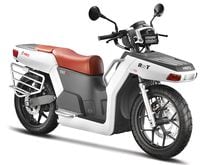India looks like the future. Even as China and other Asian nations contract, economically or otherwise, India continues to expand, with more economic growth, more educational gains, and a stronger labor force every year. Whether it’s energy, industry, or finance, India is poised to become the next superpower—an influence sure to extend to the motorcycle industry. India’s Hero MotoCorp is already the largest manufacturer of two-wheeled vehicles in the world, producing nearly 7 million (!) two-wheelers per year. Judging from these radical new Hero concept bikes, it’ll soon be one of the most influential manufacturers too.
Many of the ion’s technical solutions might exist on paper only, but it shows how creative Hero can be.
Hero released an array of fascinating and futuristic concepts at the recent New Delhi Auto Expo, heralding what Hero MotoCorp CEO Pawan Munjal called “the dawn of a new era” for his company. Leveraging the significant engineering talent of Wisconsin-based Erik Buell Racing (a company Hero now owns a 49.2-percent stake in; it also has partnerships with Engines Engineering and Magneti Marelli of Italy, as well as Austria’s AVL, all big players in the global motorcycle industry), these concepts establish Hero as a firm every bit the innovation equal of any established European or Japanese OEM.
Last year’s 240-mpg Leap serial-hybrid scooter, the first official Hero/EBR collaboration, was just the beginning. This year’s radical ion prototype is perhaps the most forward-thinking motorcycle concept ever created, with a spec sheet that reads like pure science fiction. Power comes from a hydrogen fuel cell producing electrical power stored in cutting-edge lithium-air batteries, which use revolutionary, high-surface-area carbon-nanotube technology for a claimed energy storage density of 12 kWh/kg—comparable to gasoline.
The ion is two-wheel drive, transferring power to hubless, zero-friction maglev (magnetic levitation) wheels via electric traction motors that do double duty as regenerative brakes. M-Link “anthropomorphic linkage” suspension utilizes active electromagnetic damping to continuously vary the damping characteristics in real time, while Flex-Axis steering rotates both the front and rear wheel/suspension units around the central power module, with multi-axis gyros and accelerometers modulating ride-by-wire steering for stability at all times.
Ride-by-wire steering is just one advanced control technology. Fingertip commands from the Vehicle Control Module (the VCM, or “handlebar”) are electronically converted to power, braking, and steering signals. A complex Vehicle Situational Awareness system will communicate with electronic traffic sensors to provide collision detection and avoidance abilities, issuing automatic corrections to the VCM if necessary. Full vehicle information and communications will be transmitted wirelessly to the rider’s helmet, of course.
Hero’s other major prototype, the RNT hybrid turbo/diesel/electric motorcycle, is no less ingenious, while offering significantly more real-world practicality. An all-purpose, two-wheeled utility vehicle, the RNT is powered by an ultra-economical, 150cc, 13.5-bhp engine that runs on cheap, readily available diesel. An optional turbocharger is said to double power output, while another option, a hub-mounted electric motor for the front wheel, adds more power still with the added benefit of two-wheel drive, useful on farms or bad roads.
Other innovations seem tailor-made for the developing world: An integrated generator can continuously produce 1,500 watts of 230-volt electricity, making the RNT a portable power station, while the removable LED headlight provides a useful lighting solution. Even the architecture of the RNT is uniquely intelligent. Long, flat bodywork, multiple racks and attachment points, even built-in mounting points to tow farm equipment, accommodate an endless variety of loads and accomplish tasks most other manufacturers have likely never considered for two-wheeled vehicles.
This is exactly what the Japanese motorcycle revolution looked like in the late 1950s, when industrious manufacturers like Honda and Yamaha combined innovative, up-to-date, high-capacity manufacturing capability with a unique vision for the role that a two-wheeled vehicle could play in modern society. Pay very close attention to what’s happening with Hero in India (and at EBR headquarters in East Troy, Wisconsin), where the future is now.














/cloudfront-us-east-1.images.arcpublishing.com/octane/HXOUJXQWA5HBHGRO3EMJIGFMVI.jpg)

/cloudfront-us-east-1.images.arcpublishing.com/octane/3TIWWRV4JBBOLDVGRYECVVTA7Y.jpg)
/cloudfront-us-east-1.images.arcpublishing.com/octane/KIX5O23D5NAIBGFXBN3327DKZU.jpg)
/cloudfront-us-east-1.images.arcpublishing.com/octane/7GJYDUIPXRGMTMQKN6ONYOLBOU.jpg)
/cloudfront-us-east-1.images.arcpublishing.com/octane/MUQLOVLL2ZDGFH25ILABNBXKTI.jpg)
/cloudfront-us-east-1.images.arcpublishing.com/octane/TNOU5DNE2BC57MFPMGN2EIDXAM.jpg)
/cloudfront-us-east-1.images.arcpublishing.com/octane/GTCXACQGJ5HAPDTGWUQKDEH44E.jpg)
/cloudfront-us-east-1.images.arcpublishing.com/octane/S35YGSEMEZB4BLTDJTSZPF4GLA.jpg)
/cloudfront-us-east-1.images.arcpublishing.com/octane/5UOT6HPX2JFMRJAX6EH45AR4MQ.jpg)
/cloudfront-us-east-1.images.arcpublishing.com/octane/OKWOJWAKP5EP3OACCRRWPCIX2Q.jpg)
/cloudfront-us-east-1.images.arcpublishing.com/octane/2WF3SCE3NFBQXLDNJM7KMXA45E.jpg)
/cloudfront-us-east-1.images.arcpublishing.com/octane/G4MG6OUCJNBSHIS2MVVOTPX65E.jpg)
/cloudfront-us-east-1.images.arcpublishing.com/octane/IIGGWFOTOJGB7DB6DGBXCCMTDY.jpg)
/cloudfront-us-east-1.images.arcpublishing.com/octane/QSTCM6AVEZA5JJBUXNIQ3DSOF4.jpg)
/cloudfront-us-east-1.images.arcpublishing.com/octane/U4I7G625B5DMLF2DVIJDFZVV6M.jpg)
/cloudfront-us-east-1.images.arcpublishing.com/octane/B6XD6LS6IVCQPIU6HXDJSM3FHY.jpg)
/cloudfront-us-east-1.images.arcpublishing.com/octane/ICL63FEDDRDTTMINYICCEYGMDA.jpg)
/cloudfront-us-east-1.images.arcpublishing.com/octane/FCGZHQXRBZFLBAPC5SDIQLVF4I.jpg)
/cloudfront-us-east-1.images.arcpublishing.com/octane/WNOB6LDOIFFHJKPSVIWDYUGOPM.jpg)

/cloudfront-us-east-1.images.arcpublishing.com/octane/X33NU3E525ECRHXLNUJN2FTRKI.jpg)
/cloudfront-us-east-1.images.arcpublishing.com/octane/6KKT5NNL2JAVBOXMZYS5ZO76YA.jpg)
/cloudfront-us-east-1.images.arcpublishing.com/octane/J5RKG5O455GMPGQRF2OG6LRT7A.jpg)